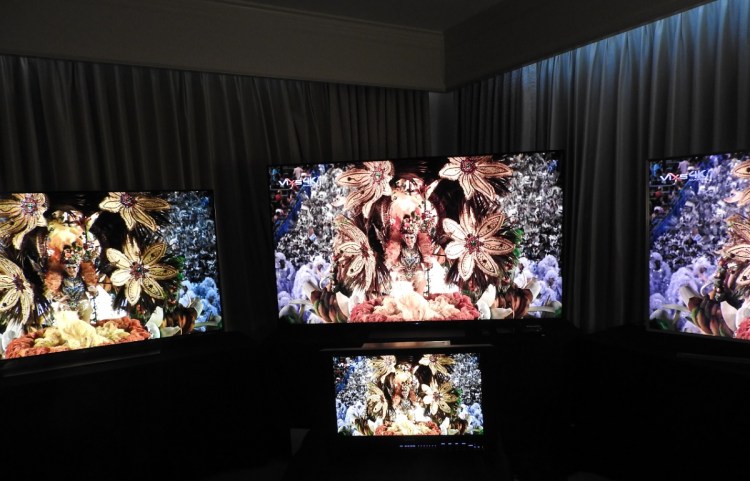Sony Electronics said today that its new 4K HDR televisions are now available for preorder at prices ranging from $2,500 to $10,000.
These kinds of TVs were popular at the recent Consumer Electronics Show, the big tech trade show in Las Vegas in January. They’re thinner than last year’s models, they display four times as many pixels on the screen compared to high-definition TVs, and they have high dynamic range, or the ability to display both dark and light features in the same image.
Sony is trying to stay in step with the times, and it is doing so by creating TVs with bigger screens. The smallest screen being offered today is 55 inches, while the biggest is 75 inches. I got a good look at the TVs at a preview event in San Francisco, where Sony tried its best to convince me that its TVs are the best on the market.
“4K is kind of a given today,” said Phil Jones, product information manager at Sony Electronics, in a briefing. “And people are gravitating to bigger TVs. We’re focused on the high end of living room TVs.”
The 4K HDR Ultra HD TVs include the XBR-X850D, the XBR-X930D, and the XBR-X940D series.
The TVs are powered by Sony’s 4K Processor X1 advanced image engine, which is dedicated to producing the “blackest blacks” and a wide range of colors. This “brain” is a step up from Sony’s TV chips for last year’s models.
“This brain is a genius,” Jones said. “It can adapt based on what kind of source is fed to it. The brain has to be very fast to deal with it. This brain is solely designed for picture quality.”
The TVs focus on picture quality, clarity, and contrast to make it seem like you’re looking at the real world.
The Slim Backlight Drive, found in the X930D series, enables an ultra-thin design and creates an expansive, borderless picture. The X930D and X940D series have an optional flush mount that enables the TV to be mounted closer to the wall than before. All of these TVs feature Google’s Android TV operating system for smart, connected TVs. They have Android TV’s Voice Search feature that makes it easy to search for content using natural speech.
That means you can use the TV remote and the TV display to control a variety of Internet of Things devices, such as your mood lights or air conditioner. The TVs will be branded with Sony’s 4K HDR Ultra HD logo.
Sunil Nayyar, director of product marketing, said the TVs shine with 4K content that is becoming increasingly common from a variety of sources. HDR content is also available from providers such as Amazon Video, which has rolled out HDR titles like “The Man in the High Castle” and “Mozart in the Jungle.”
When I looked at the edges of the older TVs, I could see a film of bright white lighting on the sides of the devices. But with the new ones, there was no film. When it was supposed to be black, it was pitch black. That makes for a better overall viewing experience and a wider viewing angle. Sony has patented this feature.
Will it make a difference? I don’t really know myself. But I could always tell which TV looked better when it was side by side with another one.
The TVs are available for presale today and will go on sale in March at Amazon, BestBuy.com, and in stores. The XBR-55X850D (55-inch model) sells for $2,500. The XBR-65X850D (65-inch model) is $3,500. The XBR-75X850D (75-inch model) is $4,500.
The XBR-85X850D (85-inch model) is $10,000. The XBR-55X930D (55-inch model) is $3,300. The XBR-65X930D (65-inch model) is $5,000. The XBR-75X940D (75-inch model) is $8,000.
Sony will also launch 32-inch to 48-inch TVs later this spring.
VentureBeat's mission is to be a digital town square for technical decision-makers to gain knowledge about transformative enterprise technology and transact. Learn More


